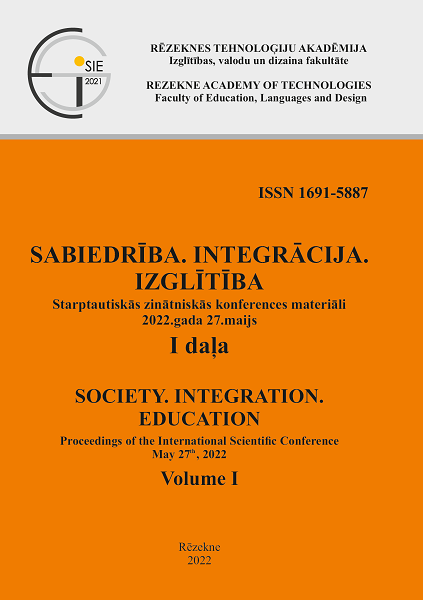CULTIVATING IMAGINATION IN EDUCATION PROCESS: CONTEXT OF PRIMARY TEACHERS’ OPINIONS
DOI:
https://doi.org/10.17770/sie2022vol1.6887Keywords:
cultivating imagination, Lithuania, primary education, teachers’ opinionAbstract
The importance of imagination in the process of education is unquestionable - by developing the ability to create and retain images, sounds, feelings as a reflection of one’s thoughts, the basis of thinking is constructed. All this helps students to discover and create something completely new, solve problems, move to other spaces, understand others.
The article theoretically substantiates the importance of developing children’s imagination and empirically reveals the opinion of primary school teachers about the aspects of developing imagination and visualization skills in the educational process.
The written questionnaire study was carried out in January – July of 2020. The study involved 390 primary school teachers which shows the validity of the data and reflects the opinion of the majority of Lithuanian primary school teachers in the context of the analysed object. The data were processed using descriptive statistics (frequency) and analytical statistics (Mann Whitney U Test).
The results of the research reveal that the imagination of primary school students is usually developed through fairy tales, character role plays, and in language teaching subjects, images are usually conveyed through verbal codes. In Maths, language teaching and Science lessons, students usually depict fantastic objects, diagrams, tables and charts, draw folk symbols, and produce visual instruments.
References
Andre´e, M., & Lager-Nyqvist, L. (2013). Spontaneous play and imagination in everyday science classroom practice. Research in Science Education, 43, 1735–1750. doi: 10.1007/s11165-012-9333-y
Bailin, S. (2007). Imagination and arts education in cultural contexts. In Egan, K., Stout, M., & Takaya, K. (Eds.). Teaching and Learning Outside the Box (pp. 101-116). New York: Teachers College Press.
Bitinas, B. (2002). Pedagoginės diagnostikos pagrindai. Vilnius: VPU leidykla.
Caiman, C. & Lundegard, I. (2018). Young children’s imagination in science education and education for sustainability, Cult Stud of Sci Educ, 13, 687–705 DOI: https://doi.org/10.1007/s11422-017-9811-7
Craft, A. (2002). Creativity and early years education: A lifewide foundation. Series: Continuum Studies in Lifelong Learning. London, New York, NY: Continuum.
Duffy, B. (2006). Supporting creativity and imagination in the early years. Series: Supporting Early Learning. V. Hurst & J. Joseph (Series Eds.). Berkshire: Open University Press.
Eberle, B. (2008). SCAMPER: Creative games and activities for imagination development. Waco, TX: Prufrock Press.
Egan, K. (2005). An Imaginative Approach to Teaching. San Francisco, CA: Jossey Bass.
Egan, K., & Judson, G. (2016). Imagination and the Engaged Learner. Cognitive Tools for the Classroom. Hawker Brownlow Education.
Eisner, E.W. (2018). The Educational Imagination: On the Design and Evaluation of School Programs, 3rd edn. Upper Saddle River, NJ: Merrill Prentice Hall.
Greene, M. (1995). Releasing the imagination: Essays on education, the arts, and social change. San Francisco, CA: Jossey-Bass.
Gündoğan, A. (2011). Adaptation of the test of creative imagination to Turkish children and the effect of drama on creative imagination of children in different age groups (PhD/Doctoral Thesis). Hacettepe University. Ankara, Turkey.
Gündoğan, A. (2019). SCAMPER: Improving creative imagination of young children. Creativity studies, 12, 2, 315–326. DOI: https://doi.org/10.3846/cs.2019.11201
Young, J.J., & Annisette, M. (2009). Cultivating imagination: Ethics, education and literature. Critical Perspectives on Accounting, 20, 93–109.
Jankowska, D.M., & Karwowski, M. (2015). Measuring creative imagery abilities. Frontiers in Psychology, 6, 1-17. DOI: https://doi.org/10.3389/fpsyg.2015.01591
Karwowski, M., & Soszynski, M. (2008). How to develop creative imagination? Assumptions, aims and effectiveness of role play training in creativity. Thinking Skills and Creativity, 3(2), 163-171. DOI: https://doi.org/10.1016/j.tsc.2008.07.001
Lindqvist, G. (2003). Vygotsky’s theory of creativity. Creativity Research Journal, 15(2-3), 245-251. DOI: https://doi.org/10.1207/S15326934CRJ152&3_14
Mackey, G. (2012). To know, to decide, to act: The young child’s right to participate in action for the environment. Environmental Education Research, 18, 473–484. DOI: https://doi.org/10.1080/13504622.2011.634494
Marsh, C.J., & Willis, G. (2007). Curriculum: alternative approaches, ongoing issues (4th ed.). New Jersey, NJ: Pearson/Merrill Prentice Hall.
McKernan, J. (2008). Curriculum and Imagination. Process theory, pedagogy and action research. USA: Routledge.
Pukėnas, K. (2005). Sportinių tyrimų duomenų analizė SPSS programa. Kaunas: Lietuvos kūno kultūros akademija.
Roy, K. (2005). On sense and nonsense: Looking beyond the literacy wars. Journal of Philosophy of Education, 39, 99–111. DOI: 10.1111/j.0309-8249.2005.00422.x
Sandri, O.J. (2013). Exploring the role and value of creativity in education for sustainability. Environmental Education Research, 19, 765–778. DOI: https://doi.org/10.1080/13504622.2012.749978
Siry, C., & Kremer, I. (2011). Children explain the rainbow: Using young children’s ideas to guide science curricula. Journal of Science Education and Technology, 20, 643–655. doi:10.1007/s10956-011-9320- 5.
Steiner, R. (1996 [1923]).The child’s changing consciousness as the basis of pedagogical practice. (Stenographic transcripts of lectures,unrevised by the author, given in Dornach, Switserland, 15th – 22nd April, 1923.) Hudson, NY: Anthroposophic Press.
Vaitkevičius, R., & Saudargienė, A., (2006). Statistika su SPSS psichologiniuose tyrimuose. VDU leidykla.
van Alphen, P. (2011). Imagination as a transformative tool in primary school education. Research on Steiner Education, 2 (2), 16-34.
Vecchi, V. (2010). Art and creativity in Reggio Emilia: Exploring the role and potential of ateliers in early childhood education. London: Routledge.
Warnock, M. (1976). Imagination. London: Faber and Faber.






